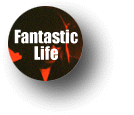

High Rise
Interviews with Asahito Nanjo and Munehiro NaritaWe're grateful to Nick Cain, the publisher of the excellent New Zealand magazine Opprobrium, and especially, writer/translator Alan Cummings , for allowing us to reproduce the interviews they did with the members of High Rise. Both of these interviews provide essential insight into the band's history. Alan's lengthy interview with Asahito Nanjo appears in a truncated form on the inside of the Dispersion CD, and is reproduced in its entirety here. His translation of an equally in-depth interview with Munehiro Narita appears on the inside of the Disallow CD in edited form, and is reproduced in its entirety here. ALBUM REVIEWSJulian Cope's Head Heritage Web Site, September 2000 Unsung Album of the Month: High Rise Live Brainiacked in Tokyo, summer '91, I staggered Godlike and beautiful off the
main drag into a blazing hot park full of rows of Japanese rock
bands, all set up in a long line down each side of the main thoroughfare.
Sooty shorts, a 'Free Your Mind & Your Ass Will Follow' t-shirt
and bare feet - I was still almost a foot taller than those around
me and weeded-out from the fine fruits of Rooster and Rizla's
international drug-smuggling. The sound that greeted me was an
a-rhythmic sonic guitar collage in which each band competed with
many others, each just two feet apart, performing for a microscopic
audience-on-the-hoof who were all, like me, mesmerized by this
not-of-this-world-music. Imagine walking one Sat'day afternoon
down Busy High Street UK to discover that every Gap Next Benneton
shop front had been replaced with its very own rock band, each
one complete with their own stage act, roadies and PA system.
For this was the scene that greeted me that afternoon, and this
is the sound of Tokyo's mighty High Rise live on stage. [* These are named after the same hill divinities who gave their name to Wiltshire's Bronze age Barbury Castle, the stone circles of the Peak District's Barbrook Moor and the various law places known as Temple Bar throughout Britain. Bar was known as 'god, the mighty' according to Gerald Massey's Book of Beginnings and 'the all-powerful' in the ancient Akkadian language. The link between the sacred hill and the speaking of the oral law thereon is still seen today. For lawyers, the bar is still 'anything referred to as an authority or tribunal: the bar of decency', according to the Collins English Dictionary, whilst the barr in Breton means the 'summit, top', or even 'Pre-Celtic 'height'; according to Adrian Room's Placenames of the World.]"-Julian Cope New York Press March 31, 2000 "It is common pop-culture knowledge that every respectable rock musician either
dies or retires prior to his 30th birthday. True, the world should
have been spared the geriatric, twilight years of such "seminal"-turned-irrelevant
check-cashers as the Stones, the Who, Sabbath, Suicide and Flipper.
But a host of groundbreaking freaks have managed to go gray and
persevere while keeping cred and integrity intact. So screw "common"
knowledge and screw mainstream pop culture along with it. If you
dig deep enough, you'll uncover a number of elders who have honed
and updated their crafts while refusing to grow cynical, tiresome
or lame: Michael Gira, Circle X, the Toiling Midgets, Daevid Allen
and dozens of others who, despite their relative obscurity, haven
proven that it's possible to mature without mellowing out. Add
the middle-aged members of High Rise, a discordant Tokyo-based
power trio, to that list. Since the early 80s, bassist/singer
Asahito Nanjo, seizure-guitarist Munehiro Narita and various drummers
have been exploring the outer limits of chaotic heaviness and
roaring velocity. The band is loosely identifiable as psychedelic
punk, but their bombastic, distorted rush is smarter and more
substantial, full of darkness, corrosion and unstable energy.
Every one of their LPs swings like an electrified nutsac. Village Voice March 22 - 28, 2000 Japan's High Rise get called "heavy" for their sheer sonic extremity-some of
their records have distorted drums. In truth, though, they teeter
on the border between pre-heavy, like the most manic garage-and
surf-rock bands, and early-heavy, like Blue Cheer. The power trio's
signature style is a high-wire act, with severe psych soloing
from guitarist Munehiro Narita precariously balancing on the rhythmic
flurries of bassist Asahito Nanjo and whichever temp drummer's
sitting in. Heaviness implies being earthbound; when High Rise
stretch out on their individual instrumental tangents, the sensation's
akin to ear- and vein-popping supersonic flight. Japan Underground, May 1999 "On the Psych Tip this time around, I want to start introducing some of the
leaders of Japan's psychedelic assault. And any discussion of
the psych "scene" (I dislike that word, and it implies too much,
but there it is) must start with Tokyo's legendary P.S.F. Records
label. Since its beginnings, P.S.F. has been associated with the
avant-garde, whether it be jazz or folk or, to the point here,
psychedelia. The label's beginnings lie with the bands High Rise
and Fushitsusha. Those bands' leaders, Nanjo Asahito and Keiji
Haino respectively, might be considered the two pillars of the
psychedelic scene. Minneapolis/St. Paul City Pages Vol. 21, Issue 1005 March 8, 2000 "DESPITE A GROWING cult in the Western press, Japan's High Rise rarely, if
ever, pose for proper band photos. Oh, there are plenty of fuzzy
action shots, usually taken during the power trio's jet-engine-test-cell-volume
live shows. But the faces are always hard to make out, with only
the guitars in vague focus--and that ubiquitous foot on the effects
pedal. It's a nice visual summary of the group's take on rock's
impulse toward "noise and coolness and delinquency," to quote
bassist and vocalist Asahito Nanjo (speaking in New Zealand's
Opprobrium). You'd never guess it from their album covers,
but each band member cuts a figure as a 1960s retro biker rebel
in black leather jacket, pinstriped bellbottoms, and sunglasses
that NEVER come off. Pretty appropriate for musicians who credit
their ax man, Munehiro Narita, with "motorcycle guitar," and sound
like a thousand Panheads with loose pipes, gunning their engines
into a Marshall stack. Time Out New York March 9-16, 2000 Issue No. 233 "The fact that...High Rise might be the most powerful rock band to ever walk the planet makes this the odds-on rock show of the year. The Japanese trio has its second US appearance, after reducing Mercury Lounge to rubble a couple of Halloweens back with its Stooges-on-hellfire garage fury. They started with frightening power and somehow turned it up a notch with every song. It's honestly one of those bands that words will always fail. Lovers of real rock&roll: Attendance is mandatory."-Mike Wolf Pop Culture Press Web January 17, 2000 "Originally known as Psychedelic Speed Freaks, High Rise has
been stalking their Japanese homeland since the early '80s, recording
dozens of albums, cassettes and compilation tracks along the way.
A power trio in every sense of the term, guitarist Munehiro Narita,
bassist/vocalist Asahito Nanjo and a succession of drummers combine
the high energy assault of punk with the improvisational spirit
of free jazz and the high-volume melodies of '60s acid rock. The
result is a monstrous but deft rock beast that blends the destructive
power of Godzilla with the understated grace of a Kabuki dancer.
High Rise could share a stage with the Stooges, the Bevis Frond
or the Caspar Brotzmann Massaker and be equally at home with any
of them. Time Out New York, No. 162 Oct. 29-Nov. 5, 1998 "Originally known as Psychedelic Speed Freaks, High Rise amplifies and brutalizes
trippy '60s punk to near-illogical extremes. The Tokyo trio revels
in the genre's bombastic tendencies, navigating the waters of
lysergic freedom with thrashing speed and reckless joy. These
legendary musicians--who claim to oppose the use of drugs--disregard
hippie-era niceties with a distinctly Japanese affinity for information
overload and noise. But instead of awkwardly regurgitating an
American rock idiom, they radically rewrite the canon while remaining
reverent enough to understand the importance of repetition and
the occasional slow, bluesy groove. Active since 1982 and signed
to the lauded PSF label overseas, High Rise has toyed with its
scrawled blueprint over the years. But its car-compacting crush
certainly hasn't been tamed by the Blue Cheer-like muskiness of
its recent LP's. Opprobrium Issue No. 3, November 1996 "This High Rise album [Disallow] will need no recommending to anyone who has already heard and liked the band. For what it's worth, though, this is as impressive as any other (despite the super stupid Ninja-chrome writing and Carcass-style 'art' on the cover). So for the most part (for four five-minute parts) a selection of change-our-minds-as-we-go punk rock riffs (check out, for instance, the better part of the Electric Prunes' mighty 'You Never Had it Better' as it's driven so fast it shakes itself nearly to pieces under the name 'Ikon') get blown up large through a thick and thunderous magnifying lens of loud fuzz and wah and the real-as-you-like feel of live jamming. What's different (from II and Dispersion, anyway), is that you can hear the drums a little better than usual, and that they sound a little worse than usual (less Stoogely, more hardcore), played this time by one PILL; and there's a longer piece of doodle-to-climax free form stuff at the end which seems a bit of a distraction from what they do best, especially when the CD is only half full. It's generally intenser, though, and closer to the punch of II than anything. They've been boiling down Vincebus Eruptum and No Sleep 'Til Hammersmith with Live Dead and a few Buffalo LP's for over a decade now, and that the tarry goo at the bottom of the pan tastes this good might just make them the heaviest power trio of all time".-Jon Bywater Village Voice Nov. 3, 1998 "The world's heaviest still-operative psych group, so massively overdriven and so permanently cranked up all the way that their songs sometimes collapse under the weight of it all. Bassist Asahito Nanjo leads a pride of like-minded bands in Japan, but this is his purest statement of intent."-Douglas Wolk Mole Number 12 Dispersion: "Car crusher drops acid, runs down your street chasing art
cars. Captures a guitar-car and treats it like a squeezebox, riffing
sparks from raw metal, stomping time with a rear axle. Once you
could only hear stuff like this on expensive Japanese pressings
(PSF label)-but this reissue brings home the burn, like Godzilla
tackling NYC. Bassist also in Mainliner, who gave encred. heavy
psych dosage on a Charnel House CD a few yrs back. Insanely unrelenting".-Jeff
Bagato Ptolemaic Terrascope No. 27, Summer 1999 "A classic power trio based around amphetamine-guitar slayer Munehiro Narita and bass/vocalist Asahito Nanjo (plus an ever-revolving carousel of drummers), the band remorselessly amplify high -energy late 60s speed-guitar punk in the Blue Cheer and MC5 mould to almost insane extremes of distortion, the sonic quality of their studio albums sounding little different to the live experience. II was only the second CD released by P.S.F., a 1993 reissue of their second LP (the first, High Rise, remains undigitalised) with two additional titles, the whole thing faithfully recreated by Squealer right down to the Obi strip (the informational paper side-sleeve found on most Japanese CDs), although translated into English for the benefit of the domestic market. Dispersion also includes an interview with Nanjo that originally appeared in Nick Cain's Opprobrium magazine out of New Zealand, (but shortly to relocate to the UK) incidentally, which effectively answers my question at the beginning of this review: the best labels and fanzines work together towards the universal good and aren't constantly leapfrogging one another in a vain attempt to have the final word."-Phil McMullen Angry Thoreauan #26 Disallow: "A live recording, but not from a live performance, I believe this to be. It is intense. A wall of sound that obliterates but does not discourage, High Rise tear through some 1960's-styled garage punk rhythms that spit psychedelia and melt metal. Brutal, heavy, tasty, spontaneous yet structured and dangerous, this is a recording that finally provides a foundation for all the hype about this Japanese trio."-Rev. Randall Tin-ear Signal to Noise May/June 1999, Issue #11 "You gotta understand, when these cats came on the stage, the ontological plastique explosion that is now known as the Japanese noise scene had already been pretty well established. Keiji Haino had been doing his thing for a good ten years, Merzbow for three or four, and Hijokaidan came around, mmnhh, somewhere in there; what am I, Alan Cummings? But part of what put people's neck muscles in a bowline about them was their in-public caressing of straight-ahead rock convention. You could hang me by my toenails from the ceiling fan and clean my nose with a corkscrew while a gutted fish repeatedly whispered the word 'psychedelia' in my ear, and I still wouldn't buy it. Nope, it's the same old lifesource: MC5, Stooges, Velvets, a quarter-cup of Crazy Horse (the band, but most likely the beverage as well) all the way back to Bo 'n' Muddy. This is probably the most American-sounding thing to come out of Japan since Pink Lady broke up, though the use of space and silence characteristic of Japanese folk music (and the aforementioned Mr. Haino) does come into play on 'Deuteronomy', the last track on Dispersion. Either that or I'm being a hopeless cultural dilettante with a tarbrush the size of a redwood. The irony this week is that as far from EuroDisney as these cats are, they sound shamelessly retro compared to some of their sweater-chewing countrymen, and one occasionally longs for the rhythm section to join Munehiro Narita on his trip to the solar core instead of hanging back at the antique shop. But as the lights dim, the credits roll, and the 20th century leans over to talk to his sidekick (I keep bringing up the millennium's end like it means something) perhaps it's time to put down the electric cattle prod called dogma and figure that even if they did wander into the wrong locker room commercially (one would figure they'd have more luck with the Guitar Wolf crowd, or old Butthole Surfers fans; there have to be at least three of those left alive, no?) this is some rifty, rooty shnoot. And I mean that, man".-Mike Zimbouski Minnesota Daily "In the concentrated world of Japanese noise and noise-rock, one must be prepared
to do three things: look/wait for records, plunk down obscene
amounts of money and plug ears intermittently. Guitar Wolf and
Merzbow (seeming opposites) lurk stateside, but psych-fuzz kings
Overhang Party and Cream-not-on-acid rockers High Rise haven't
been so lucky. Without fail, a voice in the mind's recesses whimpers
while writing out that bank-breaking check: 'Maybe someone will
reissue it here. Then I can buy it for 13 bucks.' The record store
goons, sensing your defenselessness, only laugh. Long and hard. Billboard Dec. 12, 1998 "As any record freak with eclectic tastes knows, certain album-buying tics
are the first step to Chapter 7 bankruptcy. Heckler Magazine #40 "Great stoner-pysche rawk from this Japanese power-trio. Take Sabbath Masters of Reality and mix with Creation (60's garage punk). Fans of Mudhoney, Nebula, Hendrix take note."-Jay Onyskin Feminist Baseball Issue 16 Review of II CD: "Hendrix would have loved High Rise. he would have jammed with them and members of Hawkwind and Gong at some space hippie noise festival in France in '73 or 2004. This is one of the all-time, all IN THE RED distortion overload jamming GUITAR monsters." Exclaim Magazine June 1999 "Of all the Japanese bands to be embraced by noise freaks worldwide, High Rise was perhaps the most conventional. Led by bassist/vocalist Asahito Nanjo, who later went on to form the jazzier Musica Transonic and Mainliner, this power trio took the adrenaline rush and power of the Stooges laced with the metallic wank of Blue Cheer and the improvised jamming of the MC5 and wrapped them in the dirty stomp of '60's garage rock. It's a formula that has been tried endlessly in punkier forms with '90's groups like the Hellacopters, but none come close to High Rise's biting wall of sound. The centrepiece of High Rise II is Narita's sprawling, blazing solo on the 13-minute 'Pop Sicle', which should leave all air guitarists gasping for breath. The album also contains two unreleased tracks, including a version of 'Induced Depression', originally on their 1985 debut. 1992's Dispersion, the follow-up to High Rise II, is more blues-based, yet more free form and heavier; tracks like 'Nuit' and 'Eucharist' should appeal to Kyuss fans".-Richard Moule Slug Review of Live-"High Rise combines the frantic, awe-inspiring proto-thrash energy of Blue Cheer and Mudhoney with the power blues stylings of other noted trios as Cream and the Experience (Jimi Hendrix). While High Rise may not boast the virtuoso instrumentalists that Cream and The Experience did, the group still offers the same dynamism and explosive energy. These fuzzed-out jams careen on the edge of total dissolution. High Rise delivers rock that teeters on the edge of calamity. Bassist/singer Asahito Nanjo's vocals immerse in the distortion. The screaming guitar leads and thundering drums combine to make this the most decadent live rock freak-out since the Pink Fairies' Live at the Roundhouse. High Rise's formula of excess is only parody and posturing in the hands of mere mortal musicians."-Tom Schulte Your Flesh #42 Review of II and Dispersion. "If it's too loud, you're not old enough. This, it seems, was Japan's answer to Blue Cheer, albeit twenty years later-volume, distortion, and wah abuse that puts Vincebus Eruptum to shame. Filthy sounding discs full of endless crunch and hiss, maxi-noodle guitar, and only the scantest of melodic frameworks to hang a song around. Metal at the dirty nadir it always aspired to but was hijacked away from by the Dokkens of the world. Not much to distinguish either disc from the other-it's all volume and distortion and unintelligible Japanese lyrics."-David B. Livingstone Philadelphia City Paper March 9-16, 2000 "Legends don't necessarily create themselves. Thanks to Virginia's Squealer Records and its reissue campaign, Japanese power trio High Rise has the chance to become heroes. Who can resist loud, acid-drenched psychedelia in the spirit of Blue Cheer? For close to 20 years, the band originally known as Psychedelic Speed Freaks has been making focused and improvisational noise. Bassist/philosopher Asahito Nanjo, mad-riffing guitarist Munehiro Narita and the latest in a long line of drummers are hitting the States for only their second US tour. If you enjoyed the Guitar Wolf attack last year, don't miss this demolition derby, especially with Bardo Pond in the house free to experiment behind their Prairie Dog Flesh facade".-Chris Nosal Valley Advocate March 9-15, 2000 "Got noise? Loud, brutal noise. The kind of guitar dissonance
that makes mothers demand silence at the bolted bedroom doors
of kids who can't hear a thing because the stereo maxed out and
the guitar riffs are sweet. High Rise is a powerhouse Japanese
psych band (originally known as Psychedelic Speed Freaks) with
punk riffs that jump, as well as slow grooves and improvisations
that match any free jazz group. Its searing Jimi Hendrix-style
acid rock jams go way beyond anything engineered by Black Sabbath
and Motley Crue. Around since 1982, High Rise is on a rare tour
in the US, riding the re-release of its work in America from 1998-99
by Squealer Music. The Bob "High Rise has licensed four of its older records for P.S.F. to Squealer. The ultra high energy Japanese power trio blast out bare-knuckled biker rock with frantic rhythms and guitar solos torn straight out of the tattered Stooges songbook. If you get only one, make it II-it's the most consistent. But Disallow shows them at their most free form and Live includes their most flat-out insane moments."-Bill Meyer Gajoob's DIY Report #87, 4/7/99 Dispersion: "Now this is music that is meant to be played loud. Distortion flying, drums a-knockin'- This is High Rise. The sound is late sixties blues psychedelic. The basic feel has elements of the Jimi Hendrix Experience, Ten Years After, and Eddie Cochran. This does not sound like a modern album. If you had to guess from listening, you would assume it is a 60's San Francisco psychedelic band. But Dispersion is the latest release from one of Japan's underground leaders. The sleeve plugs the disc as "explosive rock music" Cybernetic wah abuse and non-stop intensity." This did not prepare me for the rootsy feel of the album, though. The sound is definitely loose. Emphasis is on the rolling quality of the rhythm and the thunderous electric sounds ripping from the bass and guitar. The vocals are disconnected and ethereal, sounding like another electric instrument. The singing is not the emphasis, only a decoration of the rollicking distortion machine that is High Rise. The fifth track, "Eucharist", has an early Black Sabbath feel. Slow and slithery, like a biker funeral march- menacing. Munehiro Narita rips the solo-, which showers with electric sparks. He is quite obviously the focus of High Rise, and it is with him that this album rises and falls. The seventh track, "Deuteronomy", drips with reverb. The rhythm hitches and staggers its way at a dirge-like pace. It has a feel of dark highway driving with nightmarish imagery. "Deuteronomy" sounds like a reaction to a late night viewing of Twin Peaks or Natural Born Killers."-Phil Simon Gajoob's DIY Report #88, 5/12/99 II: "Hard core heavy punk metal. Buzz saw guitars squeal, shred and slam everything in sight. I like it, it's even wilder than Greg Ginn's instrumental powerhouse Gone from the mid-eighties. These tunes were indeed recorded in that dark decade by the Japanese trio known as High Rise and are now being reissued on disc in this country. These guys were out on the edge of the wave of heavy hard core punk when the guitars got a lot more crunchy and bands like Black Sabbath could be spoken of as mentors without too much snickering. The vocals, when they occur are buried in the mix, I can't tell you whether they're singing in English, Japanese or something all together different. It's all drenched in reverb too, so the effect is like listening to someone shouting at you from the other end of a subway tunnel while trains roar down the tracks. High Rise rocks with reckless abandon, full speed ahead, damn the torpedoes and all that sort of thing. It's a little on the dark side, but still quite a lot of fun...that is if your idea of fun includes guitars up to 11."-Kevin Slick ICE January 1999 "Virginia-based Squealer Music, which has issued albums by envelope-pushing
soundscapers such as the Ah Club, Tono-Bungay
and Spatula, launches its archival arm - dubbed
Squealer Revisited - this month. The label's
initial salvo, due Dec. 22, will be a pair of hard-to-find discs
from manic Japanese hard-psych band High Rise
- whose bludgeoning-yet-intricate sound, keyed by guitarist Munehiro
Narita, falls between that of Blue Cheer and Last Exit. Ink Blot Web Zine, 1/99 "The 50 second long 'Cycle Goddess' opens this record with an acrid, smoking
roar that brings to mind Davie Allan fronting the Ramones. The
energy never lets up; High Rise may be heavy, but they're never
sluggish. Guitar Magazine March 1999 "Once known by the far more evocative handle Psychedelic Speed
Freaks (talk about judging a book by its cover!), this Japanese
combo may well be the last true power trio-with an emphasis on
the first word of that expression. While not nearly as polished
as kindred spirits like Cream, High Rise exhibits a similarly
jazzy propensity for ensemble soloing leavened with the scuzzy
undertones of a particularly medicated Blue Cheer. Copper Press Issue Number One June 1999 "Although each track has a beginning and an end, where sounds form (more like erupt) and distortion fades, each slab of noise on these two domestic reissues of long-lost Japanese records hits you like the rush of walking into a hot, smoky club as a raucous rock wails away on stage in a euphoric jam. The tracks start with an often familiar guitar riff or idea, but soon deconstruct from the weight of maniacal guitar solos and break into wide-open jams, with the bass and drums keeping a solid, heady rhythm amidst the blaze of glory flaming from the guitarist's amp. No wonder these guys are legendary".-Steve Brydges All Music Guide Web Site II: "When High Rise II was recorded in 1986, the
power trio still reflected bassist/singer Asahito Nanjo's and
guitarist Munehiro Narita's enthusiasm for punk rock. They loved
the energy and attitude of punk, as well as the heaviness of Cream,
Blue Cheer and Jimi Hendrix. One High Rise II, the overall
result is an unorthodox, noisy, dissonant and very inspired fusion
of punk, psychedelic rock and late 1960's heavy metal/hard rock.
It might be hard to imagine combining the hyper, slam-pit recklessness
of the Ramones or the Buzzcocks with the heaviness of psychedelic
hard rock, but that's exactly what happens on 'Monster a Go Go',
'Cycle Goddess' and other in-your-face selections. Thankfully,
High Rise's risk-taking pays off, and the album's combination
of influences are united in a cohesive whole. Another thing that's
unusual about High Rise is its production style: Nanjo's vocals
are purposefully placed so far down in the mix that Narita's screaming
electric guitar drowns them out. Not a typical way to produce,
but oddly enough, it works. When High Rise II first came
out in Japan in 1986, it was hard to find in either the US or
Europe; however, the album finally came out in the US when Squealer
reissued it in late 1998."-Alex Henderson Live: "High Rise's studio albums Disallow, High Rise II and Dispersion are all well worth owning, but if you absolutely had to narrow your High Rise purchases down to a single CD, this live album would be the best choice. Unfortunately, the liner notes don't tell listeners what the venue was or give a recording date. But wherever it was recorded, the Japanese trio is especially powerful, especially heavy and especially freewheeling on this disc (which first came out in Japan in 1994 on P.S.F. and was reissued in the US by Squealer in 1999). This isn't to say that High Rise sounds sounded neutered or inhibited in the studio, only that it is even more forceful than usual on live versions of "Mainliner, " "Outside Gentiles" and "Sadame" as well as "Door, " "Ikon, " "Mira" and "Popsicle." In the studio, Asahito Nanjo's vocals have always been placed way down in the mix, and on stage, they're still purposely overpowered by Munehiro Narita's very prominent lead guitar. That might sound peculiar to some -- you never heard Robert Plant drowned out by Jimmy Page or David Lee Roth drowned out by Eddie Van Halen -- but oddly enough, it's an effect that works for High Rise. As appealing as High Rise's studio albums are, Live is by far its most essential CD."-Alex Henderson Disallow : "This five song EP for High Rise has about 35 minutes of high energy thrash, and if anything the intensity of their psychedelic mania has risen further from their previous recordings. Electric guitarist Munehiro Narita and electric bass guitarist Asahito Nanjo are joined by a different drummer Pill to continue building on what their influences, primarily Blue Cheer and Silver Apples, created in the late '60s-early '70s. The title track is six minutes of relentless, hard core slashing, nothing subtle, with muffled, indistinguishable vocals, prevalent throughout, and bashing, chaotic drumming from Pill. Narita is more funky and tuneful, Nanjo exploring a yelping vocal line on "Whirl, " while an all out rock assault for "Sadame, " gives fair warning to Ted Nugent to step aside. The wah-wah pedal is Narita's best friend on this, and the 4/4 hard beat thrash of "Ikon." The finale "Grab" is a feedback induced with march drums and hi-hat nine minute anthem, completely improvised. This Japanese power trio plays together like few other hard core or alternative bands. They are faithfully upholding the psychedelic freakazoid tradition of past acid rock groups in a way that, technologically, the founding fathers never had the opportunity or equipment to do."-Michael G. Nastos Philadelphia City Paper August 1999 "High Rise dwells somewhere between the sonic clobbering of the Boredoms and the hippie wandering of Ghost. Forget that this band named themselves after a J.G. Ballard novel and that their press releases compare them to Blue Cheer and even Cream. Think of them in terms of what they called themselves back in 1982 - Psychedelic Speed Freaks. Imagine Bardo Pond's Gibbons brothers adding amphetamines to their drug cocktails and you've got an idea of this Japanese power trio's sound: thudding drums, chest-crushing bass, and flagrant wah-wah abuse. Noise connoisseurs may have happened upon their original releases in past Drunken Fish records catalogs, but most are expensive and hard to come by. Disallow clocks in under 35 minutes, and, due to clean digital recording, is the more listener-friendly of the two records. "Whirl" and "Disallow" destroy classic rock riffs reminiscent of old Black Sabbath with relentless guitar work. "Ikon," which also appears on Live in a different form, is an all-out assault on the ears. Live is a longer, less accessible recording, but I prefer its dirtier, over-the-top approach. "Pop Sicle," for example, begins at an icy, mid-tempo pace but builds to the same, almost impenetrable clamor. Virginia's Squealer records (whose roster includes such easy listening as Rake, Tono Bungay and Tower Recordings) has begun a new reissue series with these two releases, and we can only hope that everything they find is this worthy of renovation." -Chris Nosal Scram #9 II: "First American issue of 1986 LP, with unreleased additional tracks.
Here the vocal sound reminds me a lot of the Nomads, and again
the guitars are fantastic pulsing beasts. Head-banging music of
the first order".-Kim Cooper Aiding and
Abetting #185, 7/26/99 Live: High Rise was a Japanese
three-piece back in the 80s. The band specialized in over-the-top
fuzzwork, a more manic version of Cream, if you will. A lot more
manic, really. This doesn't sound much at all like Cream, except that
it's three musicians works real hard to kick some major ass. The
press has high praise for Munehiro Narita's guitar work, and it's all
that and then a lot more. Disallow: "Alright. It's a bit easier to hear High Rise on this studio recording. And, indeed, with some of the extraneous live matter removed, the band does sound a little like Cream. Or, to be honest, more like Black Sabbath. Munehiro Narita's guitar slinging, however, is even more impressive in this context. He's not just crazed, but brilliantly so. A couple songs here are also on the live album. The arrangements are different. Similarities can be heard, but live I'd say High Rise is a completely different band. And better, to my ear. This album is good, and connoisseurs of fine guitar work will prefer the quality of this sound to the live stuff, but I liked the overall lunacy of the live sound more. That's all. Still, I'm knocked out. There's plenty of reasons I didn't know High Rise before. Now, there's no way I can forget."-Jon Worley
HIGH RISE MAIN PAGE • DISCOGRAPHY |





